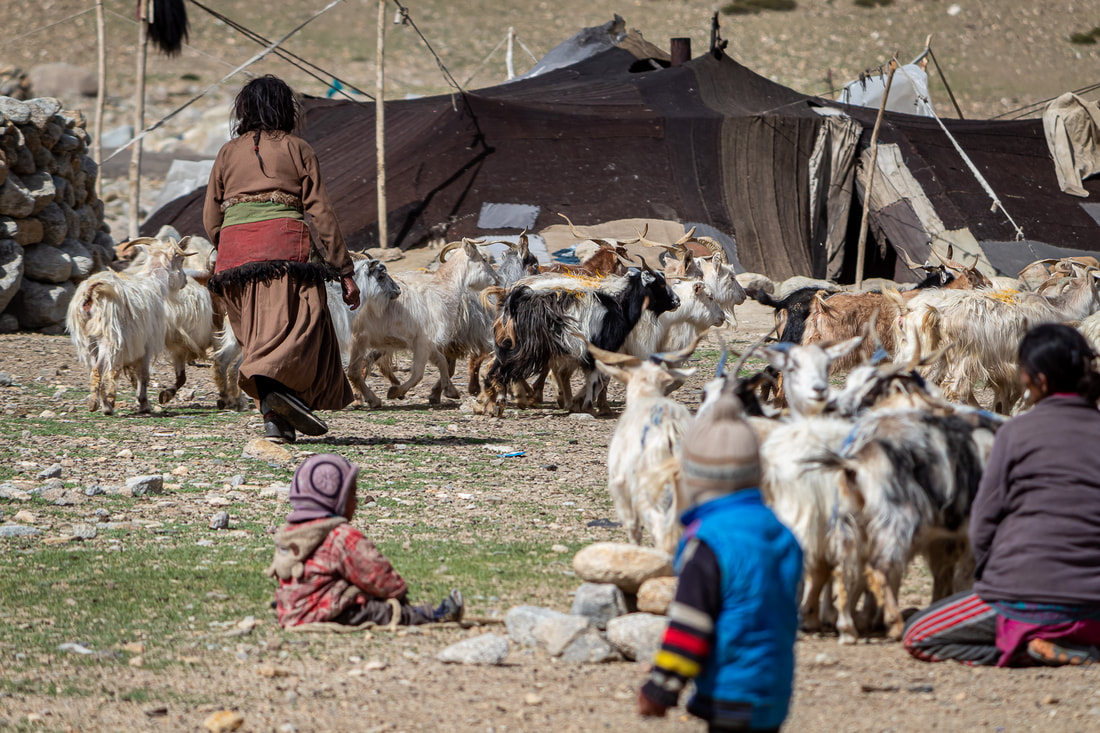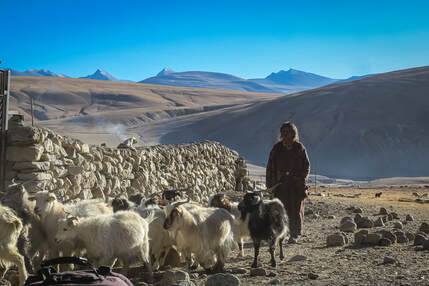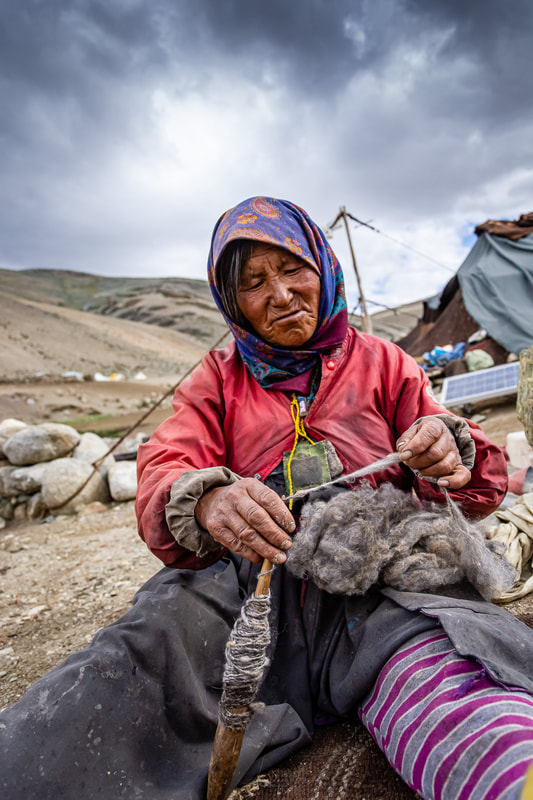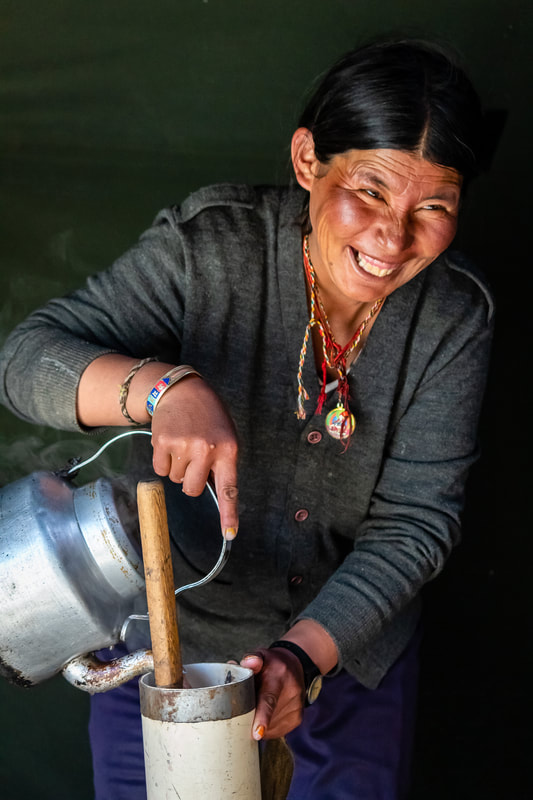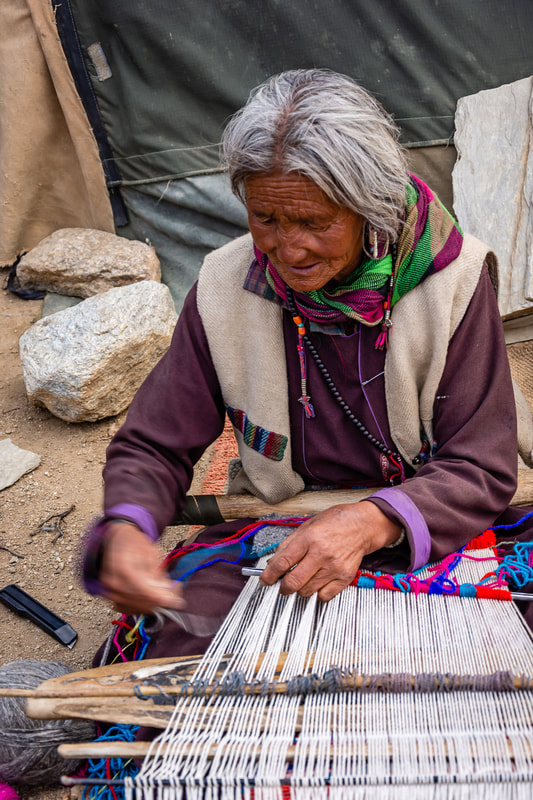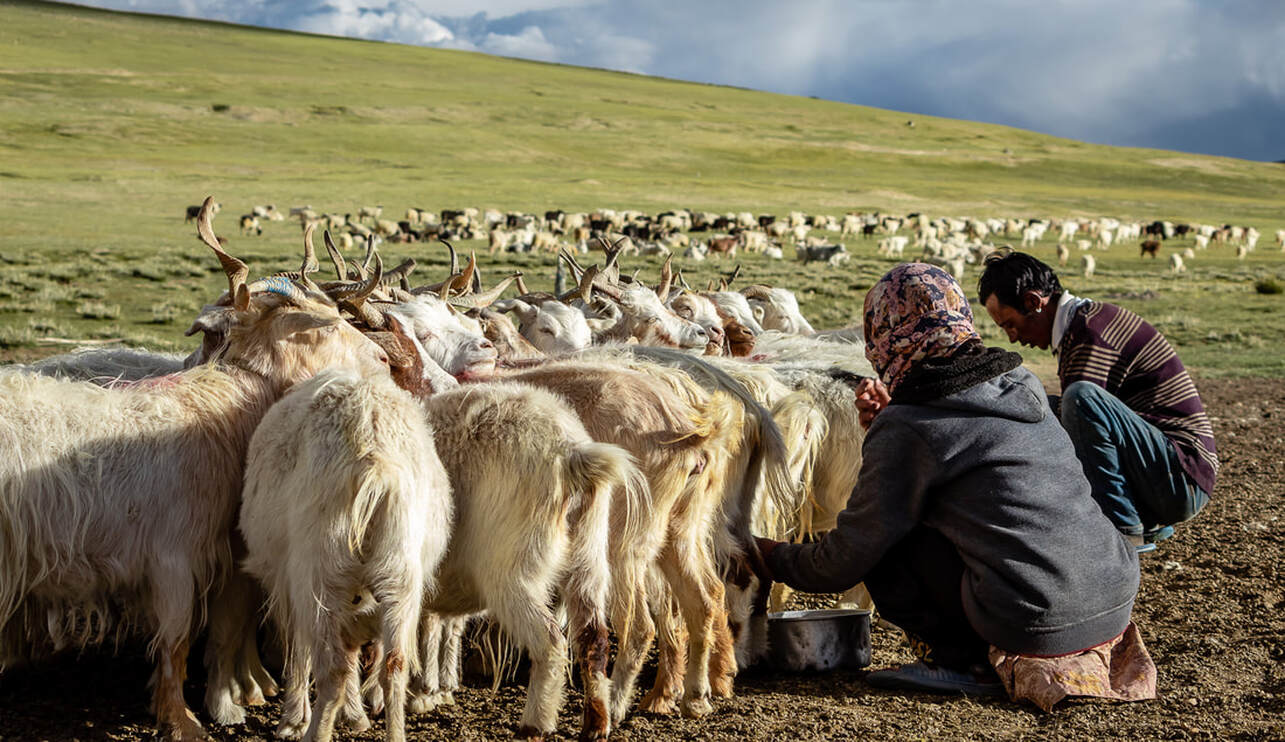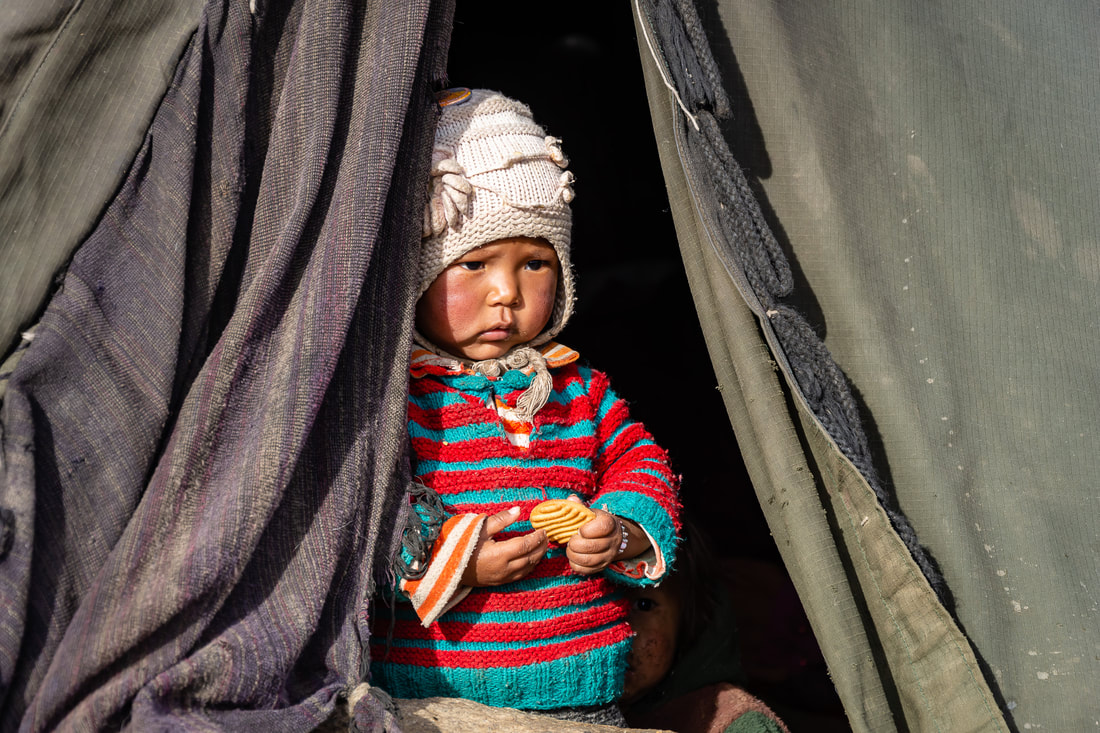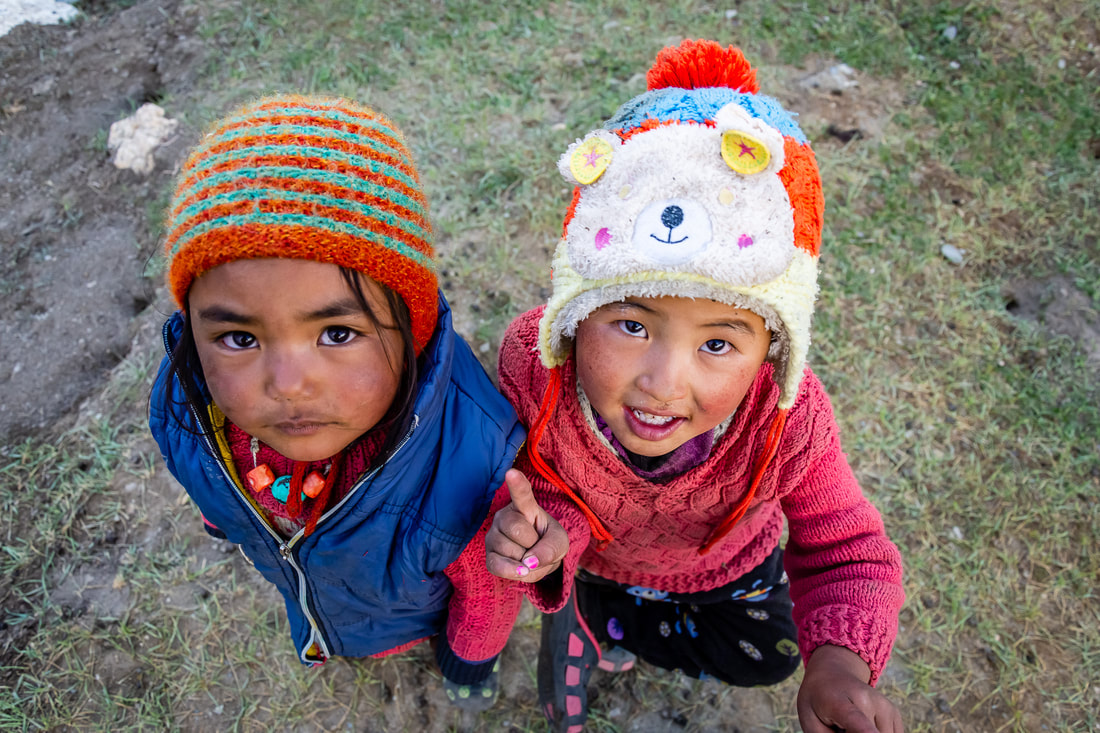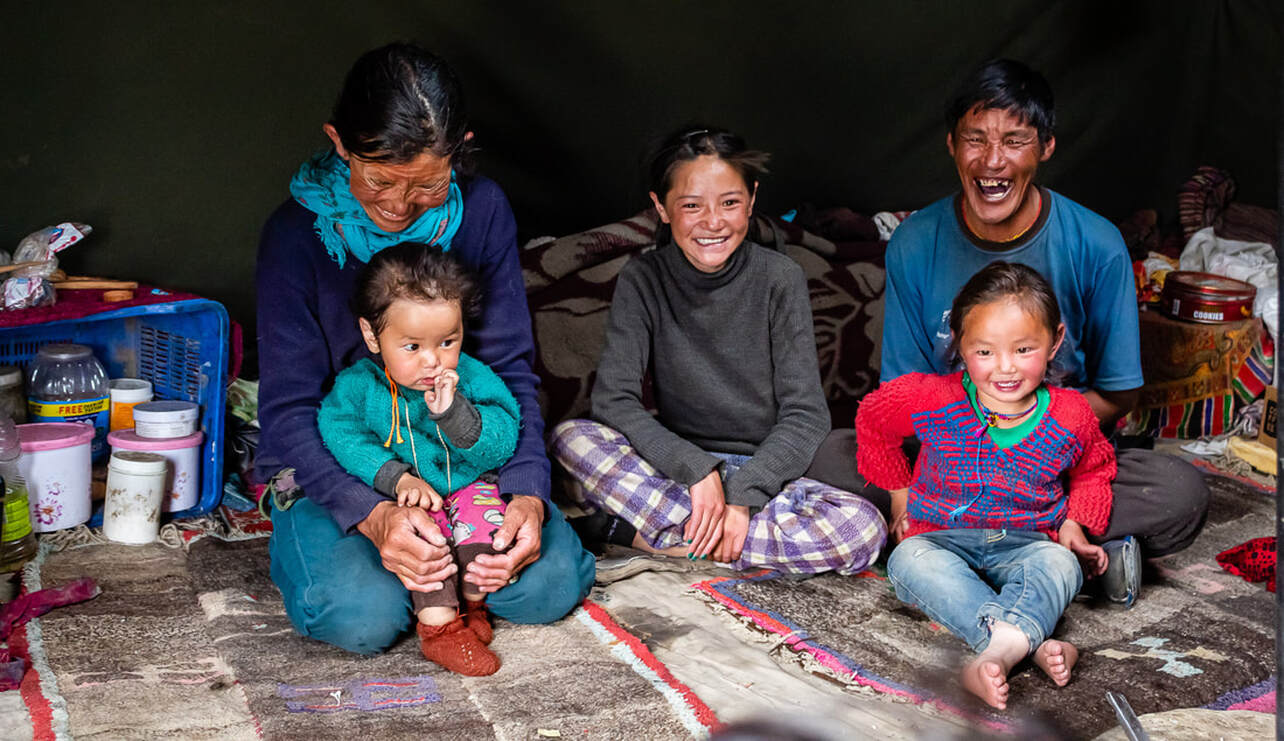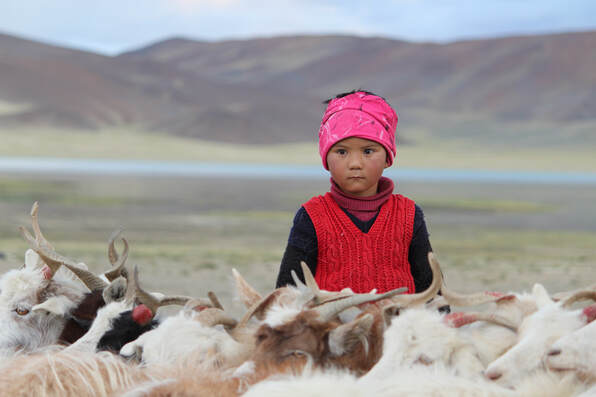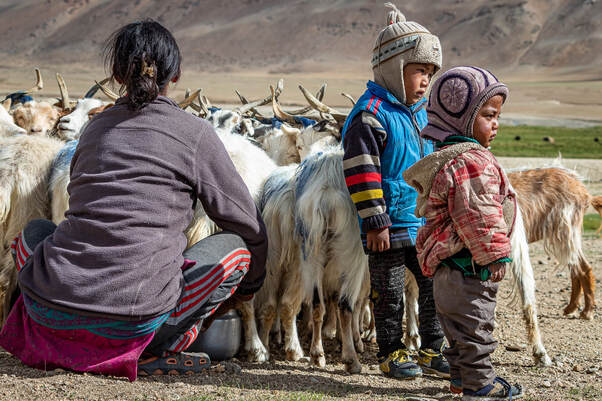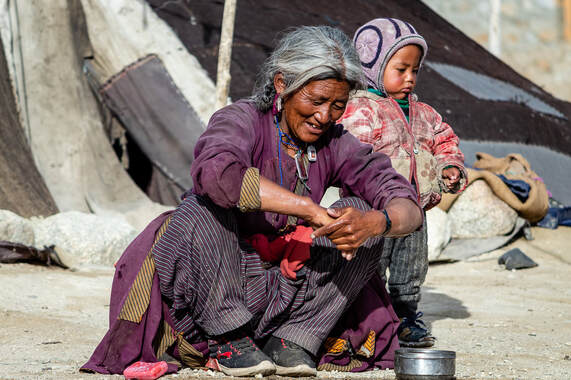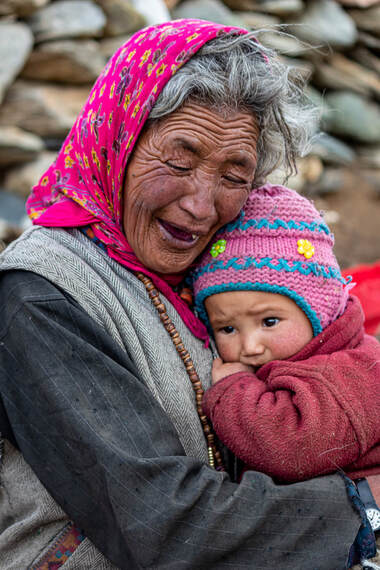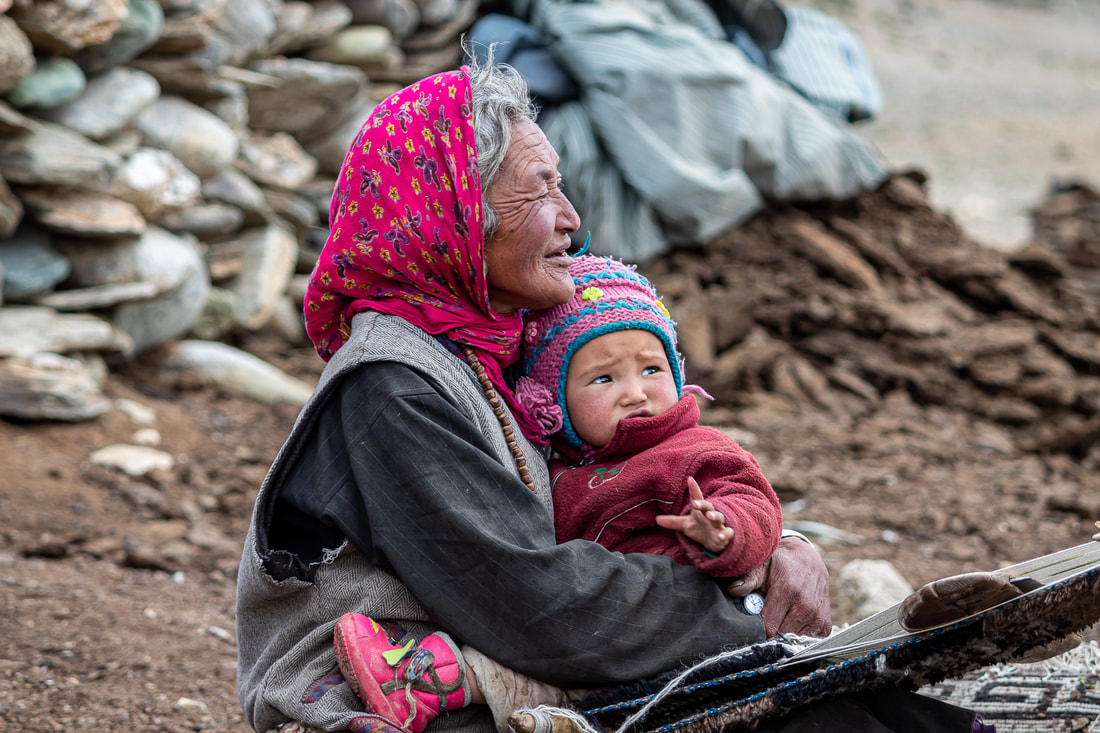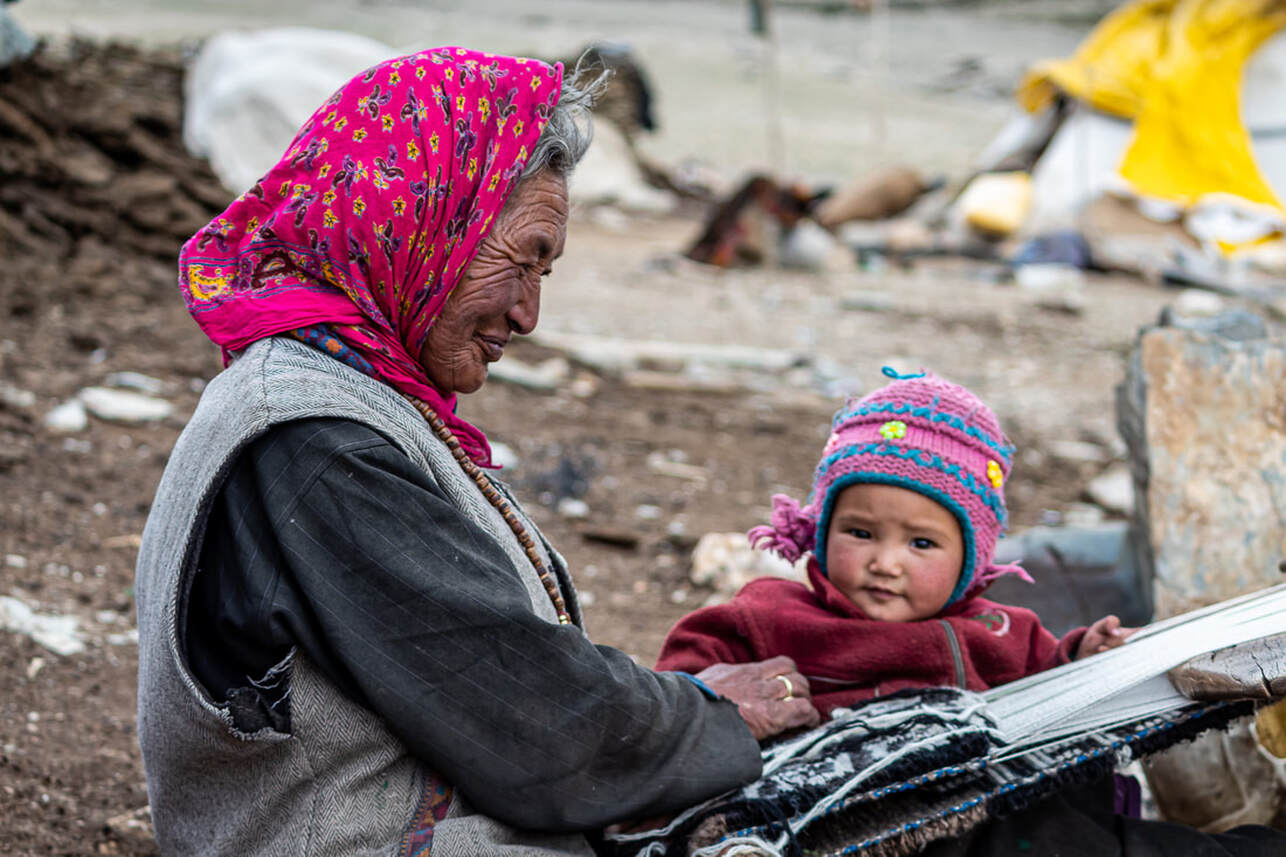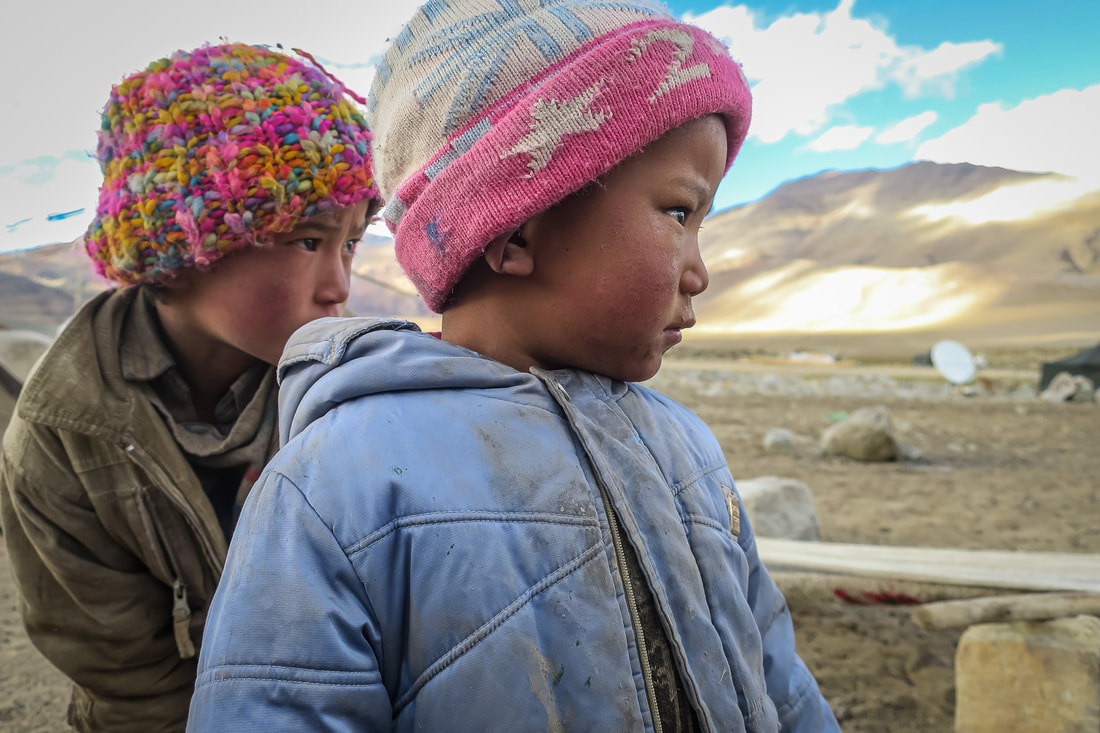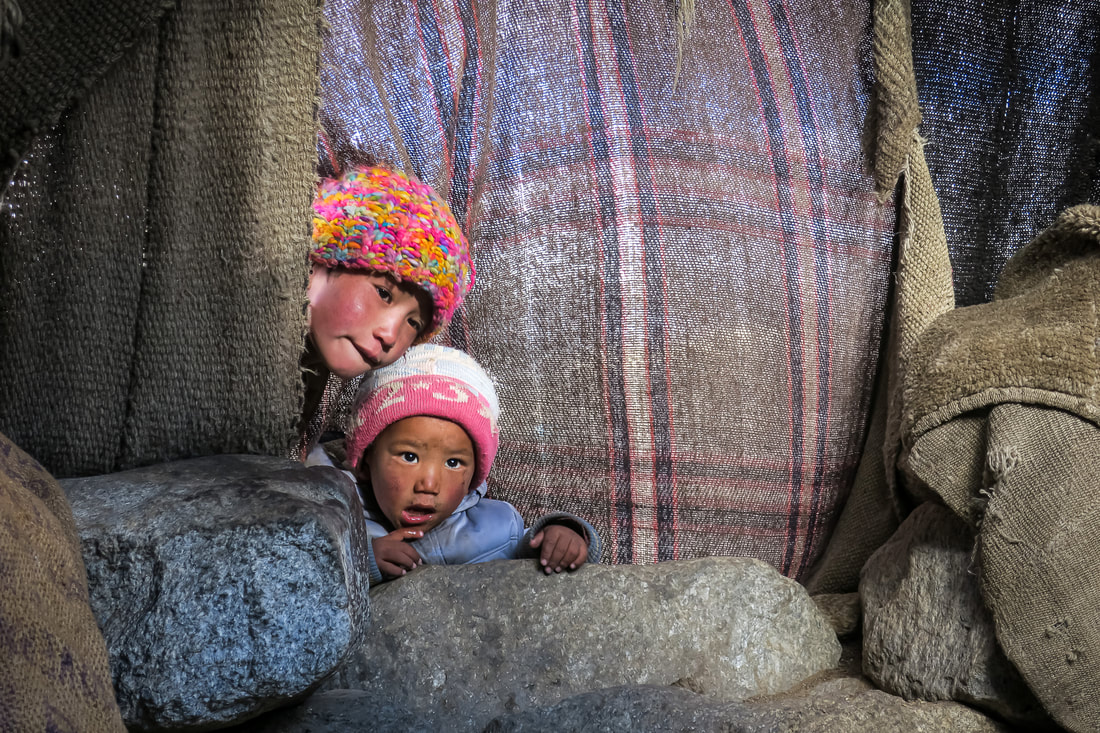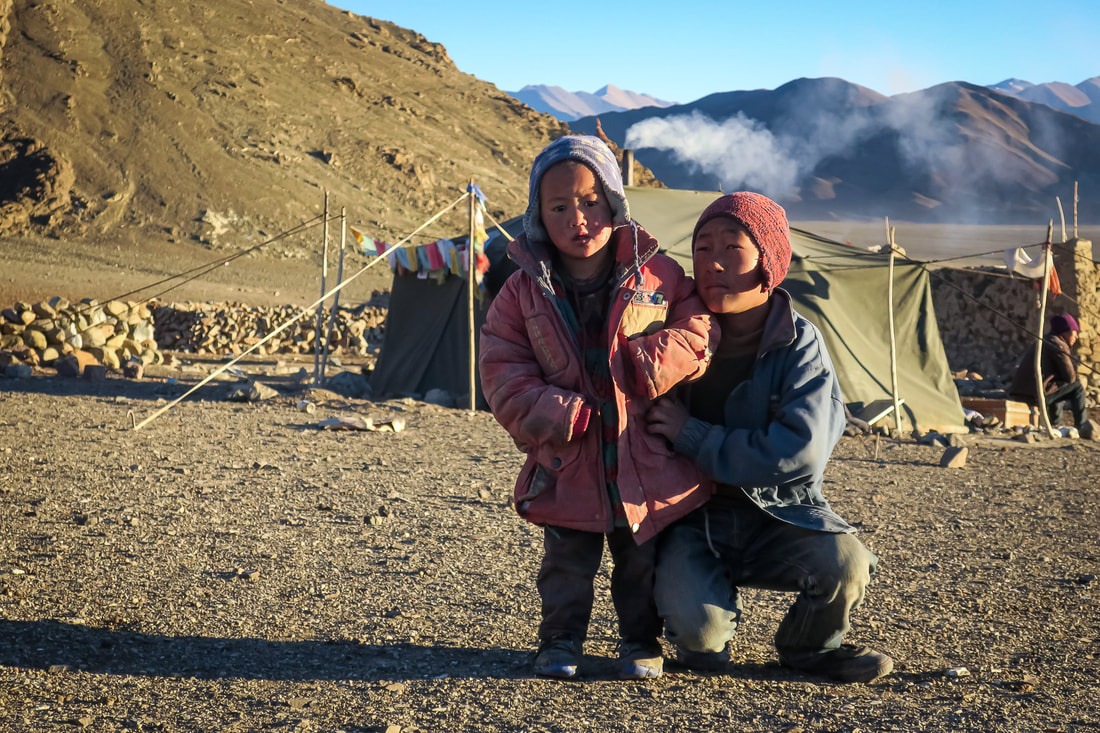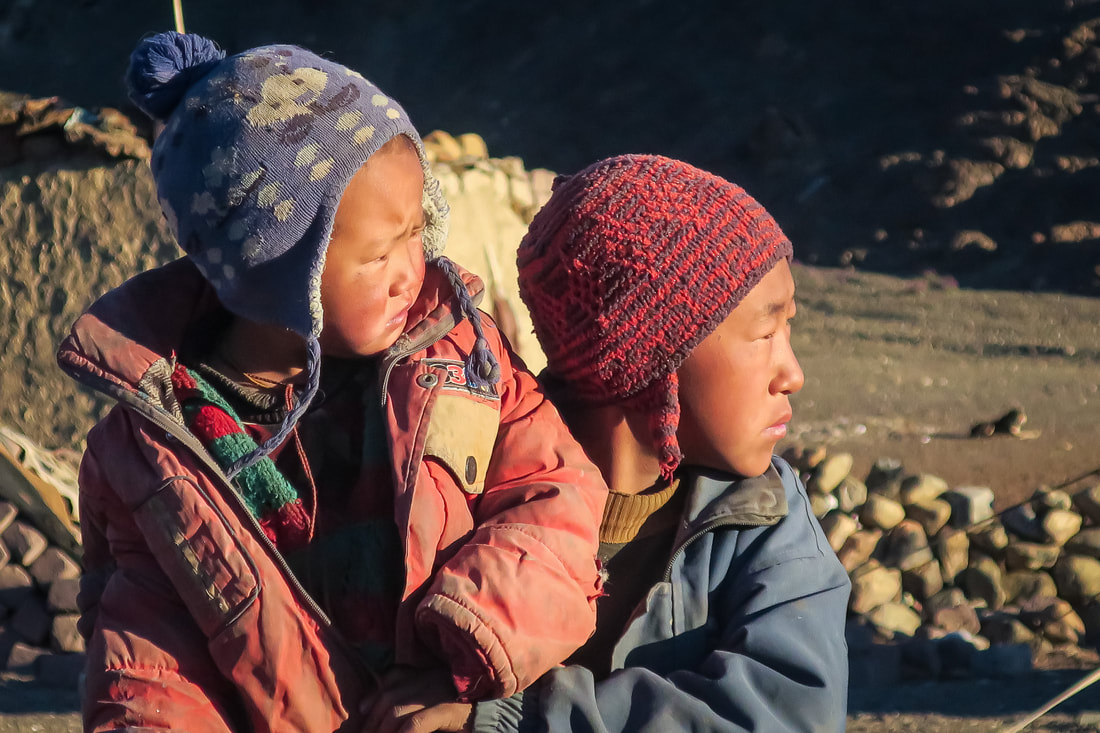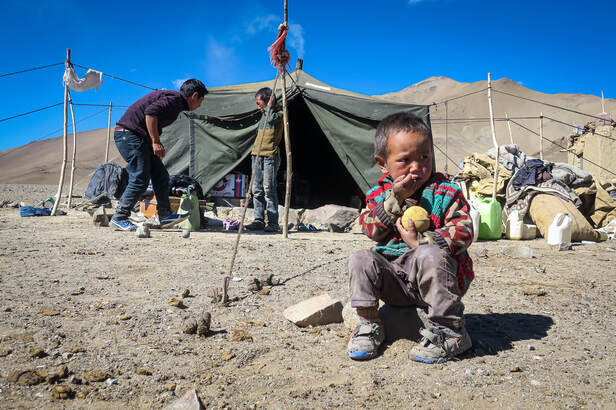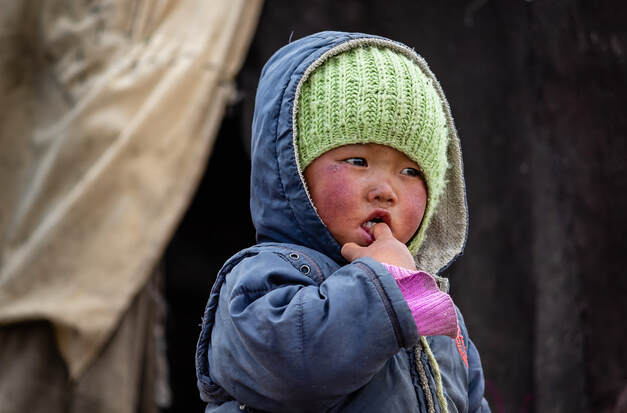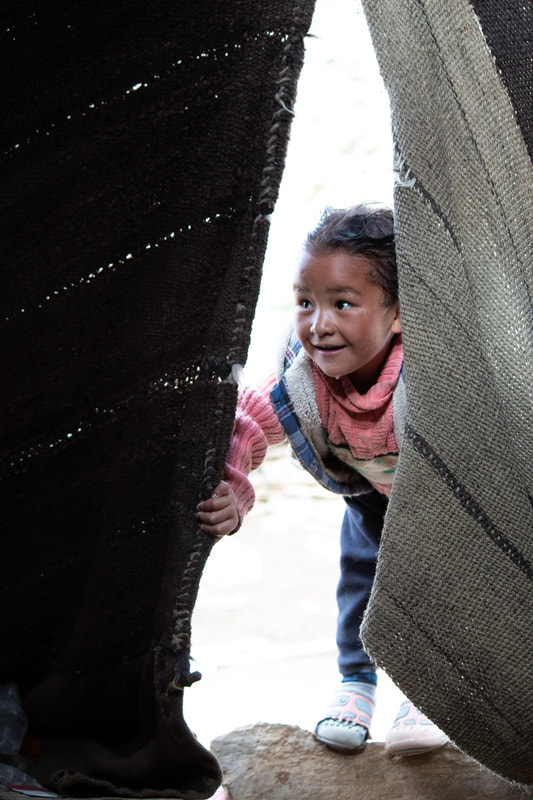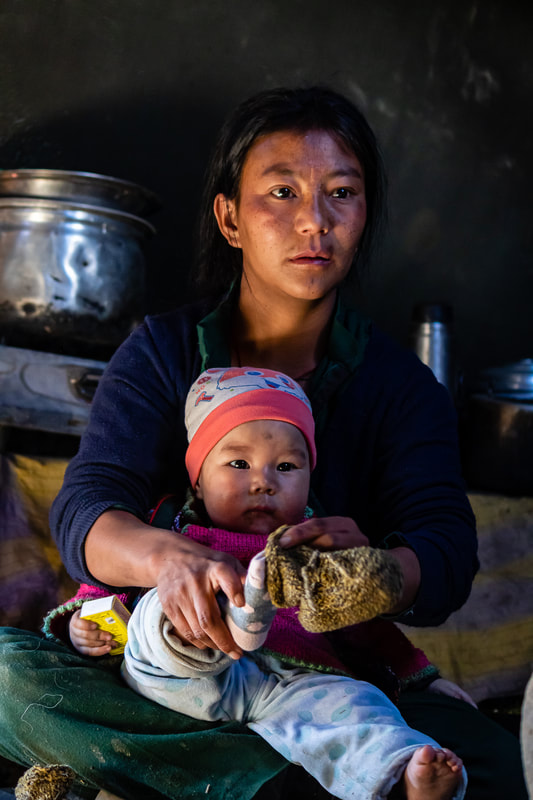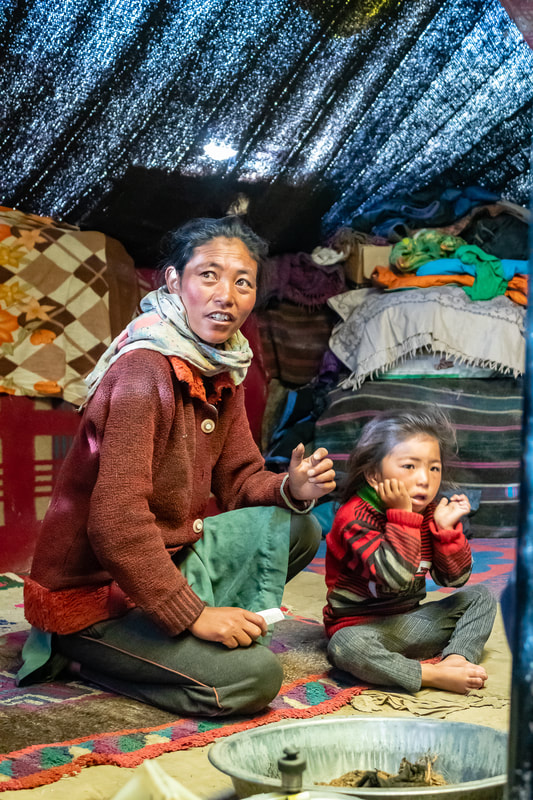Goats as Nannies? : Childhood in Cold Desert of Changthang
Text by
Nandita Chaudhary,Ph.D
Photos and Videos by
Vishwas Raj and Adventure Sindbad Stock
Changthang: The Land of Changpas
Pashmina, the legendary and luxurious fabric was patronised by Mughal royalty as early as the 16th century. Both men and women from wealthy families used Pashmina shawls, carpets, and jackets. Over generations, these have been passed down as precious family heirlooms. Around the early 19th Century, the fabric became internationally known and Pashmina shawls have since gained worldwide recognition as a luxury fabric. Although most of us are aware that this exquisite fibre is spun to its final elegance by Kashmiri artisans, a lesser-known fact is that the wool itself is harvested by a remote, nomadic community of sheep and goat herders in the northern Himalayan region, “The Changpas”. The downy undercoat of the Changthangi goat that sheds naturally every spring is harvested for wool which soon grows back into a thick silky coat to protect the animals from the harsh winter season. Unlike other woolen material, the Pashmina does not require regular shearing, these silken strands are simply combed off and collected before being transported for cleaning, spinning, weaving, and finishing. One could say that it is an ahimsa wool because of the gentle process of a collection that does not require the animals to be disturbed in any way.
The Changpas are a nomadic community of goat-herders “endemic" to the vast windswept high-altitude (4500 m) cold desert plateau – Changthang. It is located at the South-Eastern corner of Ladakh extending 1600 km eastward into Tibet and modern-day China. With expansive highlands and giant sapphire lakes, it is home to the Changpas, the wandering nomads of this land. For generations, they have roamed its huge swathes of nutritious pastures with their flocks, weathering severe temperatures, high winds, and inhospitable terrain. It is warm in the summers and severely cold in the winters, dropping to -35 to -40 degrees Celsius. It is only in these extreme weather conditions that the pashmina goats thrive to yield the best wool. Throughout the year the Changpas keep moving with their huge flocks of goats and sheep along with yaks, horses, and ferocious Tibetan Mastiffs which guard the flocks against predators – mainly wolves. Their tents are made of black yak wool to protect them from the harsh winds as they move from one encampment to the other. This yak-wool tent earns them the name ‘Rebo’ – called so by the local Ladakhis. The Rebo cover vast stretches of land over a year’s journey and some stunning locations, still hidden and unknown to most of us non-nomads. The Changpas have and are still living this hard way of life following customs and keeping the tradition of their tribe alive even today, untethered to modern society. Another aspect that helps is the protection of the Indian side of Changthang, as ‘Changthang Cold Desert Wildlife Sanctuary’ which consists of two large, world-famous lakes, Pangong Tso and Tso Moriri and much smaller, yet amazing ones across the region which totals to about 11 lakes and 10 marshes. It is only in recent times that this region along the Tibetan border has been thrown open to tourism, although only after receiving a permit issued from Leh. Changthang is also home to many rare species of migratory birds and other fauna including the vulnerable Black-necked crane, Tibetan wild ass (Kiang), Argali and other moutain ungulates as well as The Grey Ghost of Himalayas "Snow Leopard"
The Changpas are a nomadic community of goat-herders “endemic" to the vast windswept high-altitude (4500 m) cold desert plateau – Changthang. It is located at the South-Eastern corner of Ladakh extending 1600 km eastward into Tibet and modern-day China. With expansive highlands and giant sapphire lakes, it is home to the Changpas, the wandering nomads of this land. For generations, they have roamed its huge swathes of nutritious pastures with their flocks, weathering severe temperatures, high winds, and inhospitable terrain. It is warm in the summers and severely cold in the winters, dropping to -35 to -40 degrees Celsius. It is only in these extreme weather conditions that the pashmina goats thrive to yield the best wool. Throughout the year the Changpas keep moving with their huge flocks of goats and sheep along with yaks, horses, and ferocious Tibetan Mastiffs which guard the flocks against predators – mainly wolves. Their tents are made of black yak wool to protect them from the harsh winds as they move from one encampment to the other. This yak-wool tent earns them the name ‘Rebo’ – called so by the local Ladakhis. The Rebo cover vast stretches of land over a year’s journey and some stunning locations, still hidden and unknown to most of us non-nomads. The Changpas have and are still living this hard way of life following customs and keeping the tradition of their tribe alive even today, untethered to modern society. Another aspect that helps is the protection of the Indian side of Changthang, as ‘Changthang Cold Desert Wildlife Sanctuary’ which consists of two large, world-famous lakes, Pangong Tso and Tso Moriri and much smaller, yet amazing ones across the region which totals to about 11 lakes and 10 marshes. It is only in recent times that this region along the Tibetan border has been thrown open to tourism, although only after receiving a permit issued from Leh. Changthang is also home to many rare species of migratory birds and other fauna including the vulnerable Black-necked crane, Tibetan wild ass (Kiang), Argali and other moutain ungulates as well as The Grey Ghost of Himalayas "Snow Leopard"
Land of Changpas : Changthang |
Land of Changpas : Cold Deserts of Changthang |
Rebo : House on the Move |
Rebo : House on the Move
A Glimpse into the Daily Lives of Changpas
|
The Changpas live in a region of great beauty and splendour, but their lives are simple. People from all over the world seek out these remote spaces to catch a glimpse of the mountain ranges, the flora, and fauna of this vast open landscape, the beauty that can be reached only after much hardship. The Changpas are semi-nomadic people, and they appear casual and uncaring about their appearance. The harsh winds, dust, and severe winters of the desert make it quite difficult, if not impossible to maintain a well-groomed appearance. They are aware of this and remark about it as they discuss their shyness before a camera. As the cultivators of the Pashmina, this feature of their lives provides a stark contrast to its elegance. There is no evidence of mirrors to check appearances in their temporary huts and yak wool tents as the Changpas spend their days absorbed in the daily upkeep of their home and flock. Water is a precious resource in the high-altitude desert, and there is no opportunity for regular bathing. In times of scarcity, food and water have to be shared with the animals, and their warmth and care is a high priority, even before they get down to their own tasks. In winter, water is collected from frozen streams and lakes, and heated for household consumption and as a precious resource in the harsh climate, even this is shared with the sheep and goats.
|
|
The Changpas are masters of survival in this difficult terrain, following a way of life that has sustained over centuries. Family members take turns in grazing the sheep, goats, and yaks, and also rely on other members of the community on occasion. This support and sharing are crucial to survival, especially in the harsh winter season. Those who stay behind have a number of tasks in and around the camp like the care of young children, maintenance of the open animal enclosures, collection of dung and dry roots for fuel, food preparation, and if there is time, some spinning of wool for carpet making, and carpet weaving itself.Life in village homes is somewhat more settled, with access to facilities like split-level houses, water (from hand pumps), and electricity. Yet, even with more resources, the principles of careful conservation and sparing use are followed.
Let us take this example of hair-washing. “In one encounter a mother was seen washing her children’s hair. As she does so, the rinse is collected from each child’s wash into a basin to limit consumption and for re-use in the household. Just as with other household waste, nothing is thrown away. In fact, there is no concept of waste as such, everything is seen as a resource”.
Let us take this example of hair-washing. “In one encounter a mother was seen washing her children’s hair. As she does so, the rinse is collected from each child’s wash into a basin to limit consumption and for re-use in the household. Just as with other household waste, nothing is thrown away. In fact, there is no concept of waste as such, everything is seen as a resource”.
Models of Child Care
The care of children is handled differently in different parts of the world. Somewhere, a baby is cared for by both mother and father, in some places, a mother may care for her many children by herself. Another possibility is that many people care for one child as we see in some parts of the world, but among many rural and tribal communities, even in India, caring for many children by many adults is the most common model. Child care is a shared responsibility. The logic and reasoning of multiple caregiving is very special and it is adapted to the ways of life of these communities. It permits the flexibility of releasing the mother for other work, gives importance to older people, aunts, uncles, and older siblings, and it also indirectly trains younger people for caring for children before they have their own. Multiple caregiving is usually seen along with co-occurring care in which the mother or other adult attends to the child along with other responsibilities, cooking, weaving, harvesting, or other household or craftwork, work that she cannot afford to give up, even when she has a young child. There are jobs that people have to do where there is no facility for maternal or child care leave! The importance of child care can be understood best only when the context is taken into account. How we arrange the care of children is adapted to the circumstances in which we live. For instance, in affluent urban families, parents sometimes hire helpers to assist them with child care, even when there are other family members to help them. What works well in a particular setting can be maladaptive in another. For a couple who live by themselves in a city, depending on a large group of people is not a possibility they can depend on. Temporarily, however, the grandparents can and do visit their children when they have babies to help out, harking back to the old practice of learning from the older generations the basics of children’s care.
In order to illustrate this point, we look into child care among the Changpa nomads. The children of Changpas grow up with multiple caregivers in multi-generation clusters where everyone pitches in caring for the children when they are young. As soon as the children can walk and run around, they are in the company of older siblings, watched over by the group. These families, where polyandry was practiced in the past, live semi-nomadic lives and have accommodated to the harsh Himalayan desert with unique adaptations where nature itself is employed in children’s care. Let me explain.
In order to illustrate this point, we look into child care among the Changpa nomads. The children of Changpas grow up with multiple caregivers in multi-generation clusters where everyone pitches in caring for the children when they are young. As soon as the children can walk and run around, they are in the company of older siblings, watched over by the group. These families, where polyandry was practiced in the past, live semi-nomadic lives and have accommodated to the harsh Himalayan desert with unique adaptations where nature itself is employed in children’s care. Let me explain.
Growing Up in the Family of Changpas
|
The Changpa families are constantly on the move through the vast expanse of the Himalayan desert in search of grass for their animals while some families who have permanent houses in villages use these as a base from where to conduct their movement. Someone or other has to accompany the herd throughout the year, although the spring and summer seasons make life much easier because of the availability of grass near the temporary settlements. Turn-taking between family members and co-operation with other members of the cluster is arranged to ensure survival and sustenance. Elderly members and school-going children stay behind in villages, while young babies, older children during school vacations, accompany their nomadic parents on regular trips with the animals. Sometimes children are placed in State-run residential schools as they get older. For those who are permanently on the move, the nomadic way of life is a constant reality and the winter season is the hardest time of the year when families have to reach remote locations in search of fodder.
|
|
The Pashmina Nursery: Goats as Nannies ?
|
In a recent webinar titled Icing on the Lakes by Sankar Sridhar, trekker, traveler, and acclaimed photographer who has dedicated two decades to studying the Himalayas, features his project on the frozen lakes of Ladakh during his expeditions in winter season in the year 2016. During his travels, he encountered the Changpas and has many things to say about them. Winter in this region, he says, “is a time when the difference between life and death is marked by a solitary slip”. It is a time when animals sprout a special layer of fur for warmth and limit their movements to the bare minimum. The Changpas cover themselves with layers of hide, wool, and fur to keep themselves warm and keep their hearths constantly lit with fuel from animal waste and roots of a plant that they collect throughout the summer months.
Sridhar reports that the relationship between the animals and people is so close and so intensely mutual that they even permit the goats to play the role of a “nanny, cuddling them and keeping them warm when their parents are away”. This is a unique feature of the Changpas who, in return for this trust, take very good care of the animals, one can say even as they do their children. If we examine this practice with reference to the models of care mentioned above, it can find a place among the many by many options, where the warmth from the Pashmina goats is used to keep children protected in sub-zero temperatures. The scene is a vivid reminder of the documentary film Babies by Thomas Balmes where a Mongolian baby is descending from a small seat as the cattle return home. The animals are considered companions and not a threat to children and in the case of this Ladakhi community, they are even used to provide warmth. |
Co-Occurring Care and Distributed Attention
In her work about the care of young children in Indian families, Dr. T. S. Saraswathi used the expression co-occurring care which is an important departure from exclusive dyadic care characterizing dyadic adult-child relationships where instead of focusing only on the child or children, adults loosely supervise children as they go about their daily activities. Once children are fed, separately, or with the family, they spend their time around the settlements, usually in the company of grandparents and other children. The adults may take a brief pause in their work but soon go back to doing what they were. Children occupy themselves with other things around them. Co-occurring care was seen in these families. Once children are with older siblings, one-on-one care is no longer needed and these pairs or groups of children only receive distant supervision instead of constant attention. Vishwas Raj from Adventure Sindbad mentioned that he has never observed any young child crying for attention or running after the mother or father. Self-sufficiency is very evident. Yet this self-sufficiency is made possible by the presence of slightly older children, who are informally assigned to be companions cum carers. Not much of an effort is placed on personal grooming on account of the harsh weather conditions. This is a desert region and cold, dusty winds are a constant force that everyone has to learn to deal with. Covering of the face with masks, handkerchiefs, and dupattas are very common. Warm clothing is worn in layers to preserve body heat. Changing of clothes or footwear is not frequent, and mostly, garments are worn down till they are ready to be discarded.
The following three images provide an example of how a grandmother takes a short break from weaving a carpet to hold her grandchild before returning to the task.
Companions and Carers: The Omnipresence of Siblings
Although infants are carried on the backs of the adults, mother, father, grandmother, or other adults, as soon as children start walking, they are in the constant company of older siblings and other children from the cluster. This requires children to gain early autonomy from the primary carers. Older siblings provide support during this transition away from dependency and thus a close connection between the siblings develops. They spend their time watching the adults, maybe even hanging onto them, and sometimes roaming among the goats and sheep. Most of the day is spent watching others, there are few toys available to them. Older siblings are playmates, guides, and teachers, and caring for each other is an unspoken expectation. Changes may happen when one of the children enters school, especially if they are sent to a residential facility in a big town like Leh or the designated Nomad school in Puga, Changthang.
Toddlers and young children are mostly seen in pairs or small groups. Vishwas remembers that at this age, children were found to be quite shy, but at the same time, they also expressed great curiosity. They lingered in the sidelines, peeping curiously at strangers until they were comfortable enough to approach them. This region is remote and isolated and very few visitors travel to remote parts of Changthang, so children rarely encounter people from other places. Older children were also curious, but they tended to stay aloof, unlike the younger ones.
Fungible Dynamics: Whose child is it anyway?
One comment that Vishwas made during our extended discussion about the Changpa way of life is that oftentimes, he couldn’t tell whose child it was, and also, the relationships between the adults living together are hard to estimate sometimes. In fact, a person assumed to be a brother during his visit to Namgyal’s family Rebo, turned out to be a neighbour’s son from the village who had gone along for the grazing trip to help with chores. The roles and relationships are thus much more flexible and fungible in comparison with settled families. Men and women actively share the care of children as they have to manage the animals, children, home, and hearth together. Work is divided among the members of the household and turn-taking is observed, whether it relates to holding the child, churning the curd for butter, grinding the roasted barley, or feeding the animals.
School and Survival: The Persisting Battle
It is quite evident that the Rebo way of life is in direct conflict with schooling. In the documentary series on the Changpas, Kumar describes the family where he was invited to stay. The wife and her two husbands lived together along with their young daughter who had dropped out of school in Class 8. One could say she dropped back into nomadic life. Although each family would like to educate their children, having at least one child take an interest in their traditional occupation is seen as favorable. Sometimes one sibling is even held back from school for this purpose, Namgyal told us. Those who attend school could join a village school if there is one, or join a State-run boarding school if they had the resources to send the child. Coming back to children, it was also found that as they get older, children may also join Buddhist monasteries as student nuns or monks. Looking at the education policy and the lives of these children, it is hard to resolve the confrontation between traditional occupation and schooling. In a conversation about this with Namgyal, Vishwas asks him about this, and whether the nomadic way of life will disappear in the future. “No,” Namgyal says. “For now we can only hope that there is a way out of this face-off between the two options, and that school can somehow even support the local way of life through innovations." Surely the Right to Education should not need to be upheld at the cost of livelihood and we can come up with policies and practices where both these can survive without being opposed.
Lessons from Changpas on Childcare
There is so much to learn from the cultures of other people. We learn about our own past, and the possibilities of how life can be. Many of us will fondly remember visits to large families and childhood memories of listening to stories, being fed by and cared for by one’s grandparents, or other kin members. In cities nowadays, such experiences are only temporary, as the average size of the family is going down. Not only are we living in nuclear families, but fertility rates are also reducing. As family size shrinks and we move further away from kin networks, aspects of culture like multiple caregiving under the model of many children many adults, along with co-occurring care, becomes transformed.
What can we learn from observing the lives of communities like the Changpas?
We learn about their resilience and fortitude, the vulnerabilities of their nomadic lives, the survival skills that they develop for bearing the harsh winters, we learn to respect people for who they are rather than what we are like. We learn that independence and self-reliance in children is not a lesson in a nursery school, but a reality that is naturally learned as soon as children learn to walk and accompany older siblings, cousins, and neighbors around the nomadic settlement or village. They learn to feed themselves efficiently and care for the animals as the adults do, by watching rather than being instructed. Their lives are their schools and the syllabus there is survival. From the Changpas, we learn that simplicity, humility, integrity, sustainability, conservation, and survival are not words in a dictionary, but real experiences that must be learned in order to be functional members of Changpa society. This is how children become successful members of their group and carry the legacy of Pashmina weaving to the next generation.
What can we learn from observing the lives of communities like the Changpas?
We learn about their resilience and fortitude, the vulnerabilities of their nomadic lives, the survival skills that they develop for bearing the harsh winters, we learn to respect people for who they are rather than what we are like. We learn that independence and self-reliance in children is not a lesson in a nursery school, but a reality that is naturally learned as soon as children learn to walk and accompany older siblings, cousins, and neighbors around the nomadic settlement or village. They learn to feed themselves efficiently and care for the animals as the adults do, by watching rather than being instructed. Their lives are their schools and the syllabus there is survival. From the Changpas, we learn that simplicity, humility, integrity, sustainability, conservation, and survival are not words in a dictionary, but real experiences that must be learned in order to be functional members of Changpa society. This is how children become successful members of their group and carry the legacy of Pashmina weaving to the next generation.
Learning about the Changpa’s way of life and care of their children invokes in us a deep sense of respect toward these simple people, a lesson that is as precious as it is rare. Mostly we are living in our little world with small comforts that we believe we have earned. The smallest of problems can set us into an emotional spiral of complaints. Learning about people living with so much hardship who can still have the wisdom, resilience, and dedication to nurture their animals like their own children is a lesson that is hard to forget. In our country, we are incredibly fortunate to have places like Changthang to look up to and learn from.
Link to Original Blog : Goats as Nannies? Childhood in the Himalayan Desert at MasalaChaiMusing
Acknowledgment: We will like to thank all the Changpa families who shared their life with us and allowed us to capture the tender moments of their lives and discussed their interactions with children. We will like to thanks Tamchos Namgyal of Mudh for being a friend, guide, and companion during most of our travels into Changthang and from whom we could get a deeper insight into nomad movement and lives. We will also like to thanks Arun Thakur, an amateur yet gifted photographer who interned with Adventure Sindbad during one of the seasons when some of these amazing photos were taken.
Image and Video Credits : Vishwas Raj and Adventure Sindbad Stock
Image and Video Credits : Vishwas Raj and Adventure Sindbad Stock
|
25-07-2020
|
Explore | Share
|
|
Nandita Chaudhary, Ph.D
Author | Consultant |
She is a consultant and collaborator for projects, programmes, and publications on Child Development, Family Studies, and Cultural Psychology with specific reference to Indian communities. She blogs at Masala Chai: Musings about little people. She has taught at Lady Irwin College, University of Delhi. She has been a Fulbright Scholar and Senior Fellow of the Indian Council for Social Science Research.
|
|
He is the founder of Adventure Sindbad, an adventure travel company specializing in small group adventures in the Himalayan regions of India, Nepal, and Bhutan. He enjoys exploring remote places, minimalist lifestyles, and documenting them through photography. The Changpa Nomad series is his pet project after being inspired by nomad stories from his adventures in the region during photography workshops, treks, and river trips. He feels fortunate to have shaped his profession around his passion. He enjoys reading, cinema, whitewater kayaking, and running.
|
